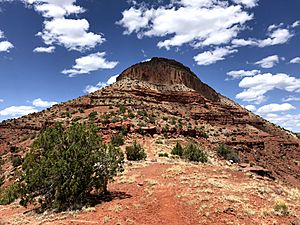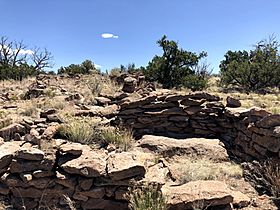Astialakwa facts for kids
Quick facts for kids AstialakwaAstialakwa Archeological District |
|
|---|---|
| Native names English: Walatowa Navajo: Mąʼii Deeshgiizh |
|

The Fortress of Astialakwa, near Jemez Pueblo.
|
|
| Type | Prehistoric/historic aboriginal |
| Location | Santa Fe National Forest |
| Nearest city | Jemez Springs, Sandoval County, New Mexico, USA |
| Elevation | 6,975 feet |
| Built | prior to 1500 AD |
| Built for | habitation, agriculture, fortification, refuge |
| Demolished | 1694 |
| Architect | Ancestral Puebloans |
| Architectural style(s) | Linear plaza ladder-type construction |
| Reference no. | 84003010 |
Astialakwa was an ancient village built by the Ancestral Pueblo people. It is also known as Walatowa in the Towa language and Mąʼii Deeshgiizh in Navajo. This special historical site is located in the Jemez Springs area of New Mexico. It is officially recognized as an important place on the National Register of Historic Places.
Contents
What Was Astialakwa Like?
Astialakwa was a strong, fortified village. It was built on top of a very tall ridge, about 800 feet high. This ridge was like a detached mesa (a flat-topped hill). From this high spot, the villagers could look out over the Jemez creek. The people living here spoke the Towa language.
Village Design and Buildings
Astialakwa was built with a special "ladder-type" design. It had long, open areas called plazas. Many rooms were built around these plazas. The walls were made from unhewn (rough) tuff blocks. This shows that the village was a home for people. It also served as a safe place during attacks.
What Can We Still See?
Today, you can still find many signs of the ancient village. There are remains of rooms and defensive walls. You can also see petroglyphs and other rock art. These are pictures carved or painted on rocks. The area also had places for farming. This village was important between the 1500s and the mid-1600s.
A Brief History of Astialakwa
Before the Spanish arrived, the Jemez people lived in many villages. In 1598, Juan de Oñate and his men took over the area. They built missions and made the Jemez people move. The Jemez people had to leave their old homes. They moved to three new settlements with missions. Astialakwa was one of these settlements. The others were Gyusiwa and Patokwa.
In 1692, Diego de Vargas came back to take control of New Mexico. In 1694, he led an attack on Astialakwa. This event is known as the Battle of Astialakwa.
The Battle of Astialakwa
The Battle of Astialakwa happened on July 24, 1694. A group of 120 Spanish soldiers fought the Jemez Pueblo people. These soldiers were led by the Spanish governor, don Diego de Vargas. They also had help from allied fighters. These allies were from the Zia, Santa Ana, and San Felipe pueblos.
What Happened During the Battle?
During the battle, many Jemez people lost their lives. Others managed to escape. Over 360 Native women and children were captured by the Spanish. Some people chose to jump from the mesa rather than be captured. After the battle, Vargas ordered the village to be burned. He also gave the animals and food to his allies.
Why Did the Battle Happen?
This battle was partly a response to the Pueblo Revolt. In 1680, over 30 Pueblo villages united. They rose up against the Spanish forces. This revolt led to the deaths of many Spanish people.
Today, the descendants of Astialakwa survivors live at Jemez Pueblo. It is not far from Guadalupe Mesa. They continue to share their culture and history.
Images for kids
Astialakwa Archeological District is located near Jemez Pueblo, NM, USA. Access to the site is restricted.





